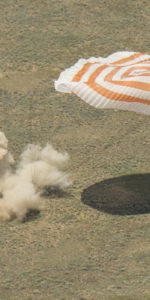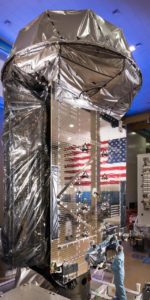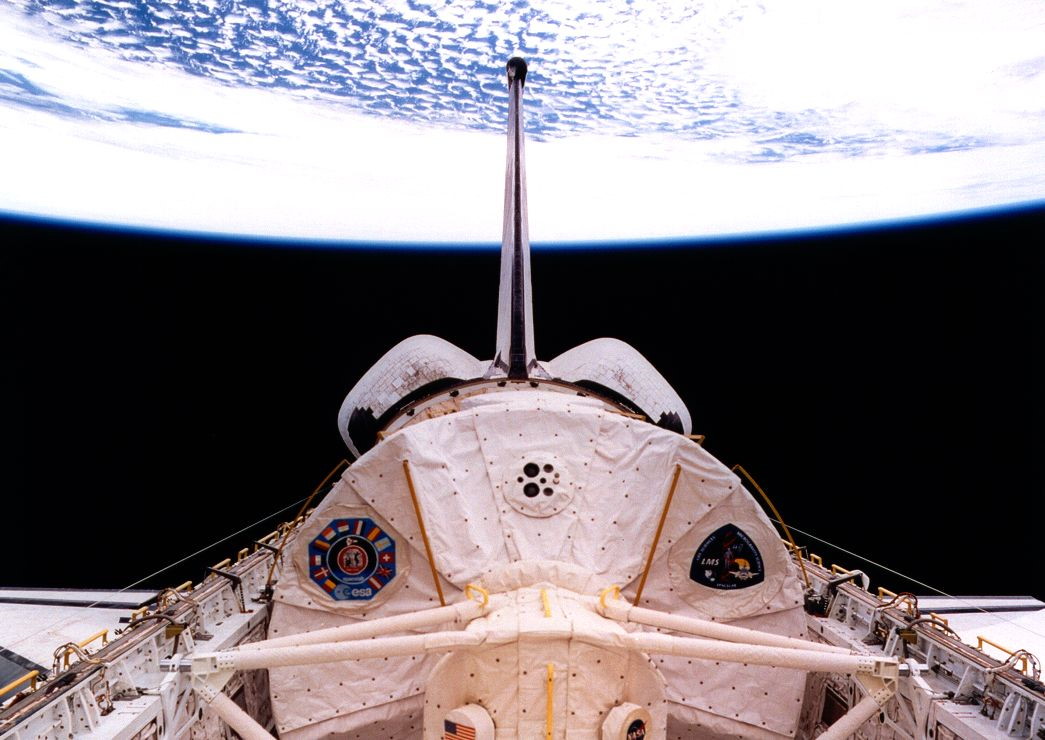
Twenty years ago, tomorrow, Earth-bound viewers gained an unearthly perspective of a space shuttle crew roaring to orbit. For the first time, a tiny video camera was mounted in Columbia’s forward flight deck as she launched on her 20th mission, STS-78. Its footage—which focused on Commander Tom Henricks and Pilot Kevin Kregel—began just prior to the thunderous ignition of her three Space Shuttle Main Engines (SSMEs) and twin Solid Rocket Boosters (SRBs) and continued through her establishment into a 39-degree-inclined orbit. As outlined in yesterday’s AmericaSpace history article, STS-78 was dedicated as a “stop-gap” science mission to bridge the gulf between the twilight of the Spacelab era and the dawn of research aboard the International Space Station (ISS).
The Life and Microgravity Spacelab (LMS) was a truly international affair, mirroring the levels of co-operation which would later be seen aboard the space station. The European Space Agency (ESA) provided its Advanced Protein Crystallization Facility (APCF), which was installed aboard the Spacelab module a mere 24 hours before liftoff—whilst Columbia was vertical on the launch pad—as well as the Advanced Gradient Heating Furnace (AGHF) and the Bubble, Drop and Particle Unit (BDPU). These three research facilities yielded more than 5,000 video images, and generally performed far better than in pre-flight tests, although the BDPU succumbed at one stage to a blown fuse and required a touch of in-flight maintenance by the crew. Halfway through the 17-day mission, the BDPU experienced another glitch, prompting Mission Control to uplink a video repair procedure to the crew, which was successfully implemented.
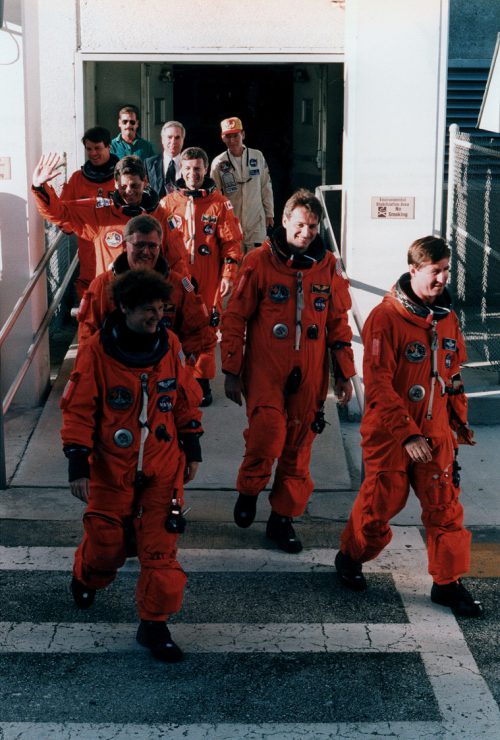
In accordance with this international flavor, STS-78’s crew—including prime and Alternate Payload Specialists (APS)—originated from no fewer than four discrete sovereign nations. The prime duo were French physicist and metallurgist Jean-Jacques Favier and Canadian physician Bob Thirsk, backed-up by Italian physician Luca Urbani and Spanish aerospace engineer Pedro Duque. Speaking at the post-flight press conference, Tom Henricks noted that the astronauts trained as a crew of nine throughout the fall of 1995 and into the first half of 1996, with Urbani and Duque supporting the mission as Crew Interface Co-ordinators from the Payload Operations Control Center (POCC) at NASA’s Marshall Space Flight Center (MSFC) in Huntsville, Ala.
LMS was unusual in that it was only announced in December 1994. “Experiments for the mission were developed on a fast-track schedule, about 21 months, versus 36 to 48 months for most Spacelab missions,” NASA explained in its STS-78 press kit. “This faster turnaround time from selection to flight also will hold true for many Space Station experiments.” Following the announcement of LMS—whose dual life sciences and microgravity sciences research thrust provided an extension of previous International Microgravity Laboratory (IML) and Spacelab Life Sciences (SLS) missions—the crew was named in relatively short order. NASA Mission Specialists Susan Helms, Rick Linnehan, and Chuck Brady were announced in May 1995, together with the Payload Specialist quartet, with Henricks and Kregel named the following October. The link with Spacelab and space station missions was tangible: Thirsk and Favier had already served in the APS role for Mission 41G in October 1984 and IML-2 in July 1994, respectively, whilst Duque had been a backup for ESA’s EuroMir ’94 flight to the Mir space station and Urbani had participated in a long-duration simulation aboard a mockup of the Columbus lab. Meanwhile, Henricks had previously served as Pilot of a Spacelab mission and, in time, both Helms and Thirsk would go on to fly multi-month-long ISS expeditions.
Having launched into orbit on 20 June 1996, Columbia’s crew followed a single-shift program of operations. In addition to the microgravity sciences, the crew supported a solid series of life sciences experiments and included among its number two physicians (Brady and Thirsk) and the first veterinarian selected by NASA for astronaut training (Linnehan). Their research thrust emphasized human physiology, musculoskeletal, metabolic, neuroscience, and space biology, and got underway immediately after the shuttle reached space with the donning of electrodes and sensors to measure eye, head, and torso motions for a Canadian Space Adaptation Syndrome (SAS) investigation.
Elsewhere, the astronauts measured their muscle performance and function with the Torque Velocity Dynamometer and gauged the effect of prolonged spaceflight exposure on their lung performance and respiratory muscles. A pair of specialized “blocks” of time, each lasting three days, were set aside to examine their sleep and performance patterns. This was the first time that sleep, circadian rhythms, and task-performance had ever been explored in such depth in the microgravity environment. Investigators hoped that tracking the astronauts through the 16 orbital “sunrises” and “sunsets” of each 24-hour period might yield clues to aid sufferers of jetlag, as well as workers of unusual shifts on Earth.
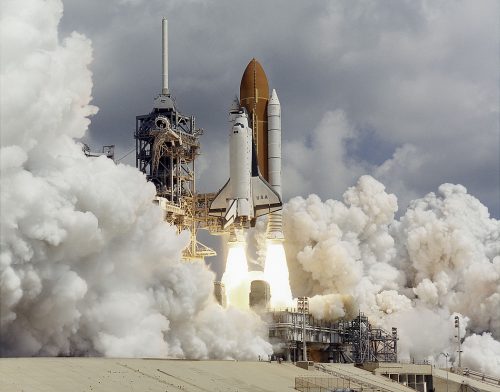
Nor was the LMS research entirely confined to the bus-sized Spacelab module in Columbia’s payload bay. A bicycle ergometer—fitted with a large, weighted flywheel and braking band—had also been set up in the shuttle’s middeck. Paying light-hearted tribute to the electrodes they wore, the blood samples they surrendered and the electrical stimuli to their calf muscles that they endured, the science crew of Linnehan, Brady, Favier and Thirsk came to nickname themselves “The Rat Crew.” Even their food and drink intake over the two-week mission was closely measured.
Their sacrifice was not lost on Commander Tom Henricks. “I’m one of those non-scientist pilots who believes that doing medical experiments in orbit is part of an astronaut’s job,” he later told a Smithsonian interviewer. “When so few humans go to space, we’d better get as much information as we can out of every person who goes. In my opinion, people who don’t want to participate in those experiments picked the wrong profession.” Summing up the science crew’s efforts, Henricks described his awe at the discomfort they experienced and their bravery for going through so much in the name of science.
In addition to LMS’s human passengers, the Spacelab mission also featured 36 embryos of the hardy Medaka fish, who were flying as part of a study of gravity’s role in the development of animals. Known for their tolerance of reduced temperatures, the Medaka appeared to develop at a slower rate than their Earth-based “control” counterparts.
For Thirsk, the STS-78 mission made him the first astronaut to write, file, and have published a newspaper story, whilst still in orbit. “Every morning, within minutes of wake-up,” he wrote for the Toronto Sun on 29 June, “we pass over a virtually cloud-free Europe and Asia. I rush unshaven to the window with a camcorder to capture the view one more time. The orbital pass begins over Portugal and Spain, through the Mediterranean Sea, across the boot of Italy and the Peloponnesian peninsula. We overfly Cyprus, Israel and the Persian Gulf. Clouds then begin to thicken as we near India and Sri Lanka, which are now in their monsoon season. It is a thrill to recognize features such as the Straits of Gibraltar, the Bay of Naples, Mount Vesuvius, Athens, the Jordan River and the Nile Delta. These are regions of Earth that were the cradle of civilization millennia ago and even today play a major role in global affairs.”
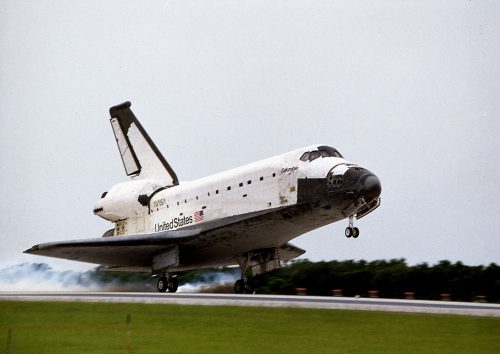
Scheduled to run for 15 days and 22 hours, STS-78 would have slightly pipped Columbia’s previous “personal best” mission duration—set a few months earlier on STS-73—and come just a few hours shy of the 16.5 days spent aloft by shuttle Endeavour’s STS-67 crew in March 1995. However, on 29 June, after careful and judicious conservation of Columbia’s supplies, Mission Control told Henricks that his mission had been extended by 24 hours, producing a landing date of 7 July and a new record for the Space Shuttle Program. The news was accompanied by an appropriately dramatic soundtrack from the movie Mission: Impossible, to which Henricks retorted that the crew was “willing, able and eagerly anticipating” the extension of their flight.
Observing Independence Day in orbit on 4 July—and becoming the fourth shuttle crew to do so—the STS-78 astronauts pressed on with their highly successful mission. “We have 41 Principal Investigators involved,” explained Mission Scientist Dr. Patton Downey of MSFC, “and all but very few have 100 percent, if not 200 percent, of the data they hoped to collect.” Telescience would be a critical asset for ISS operations and was successfully trialed, with Kevin Kregel lauding the ability to conduct video conferences and uplink videotaped repair instructions. “It made fixes a lot easier,” he said, “as opposed to sending up the message and trying to interpret the fix on paper.”
Finally, at 6:37 a.m. EDT on 7 July, the Orbital Maneuvering System (OMS) engines in Columbia’s tail ignited to begin the return journey back to Earth. An hour later, after a record-setting 271 orbits, she alighted on Runway 33 at the Shuttle Landing Facility (SLF) at the Kennedy Space Center (KSC) in Florida. All told, STS-78 had run for 16 days, 21 hours, 48 minutes, and 30 seconds, eclipsing STS-67’s record by about six hours. A tiny camera, affixed to a bracket on Kregel’s glare shield, provided an interesting perspective of the final approach and landing rollout.
“It’s been a pleasure to stay up this long,” Henricks said after disembarking, “and we know it will be a short-lived record.” Indeed it would be. On Columbia’s very next mission, STS-80, the queen of the shuttle fleet—which first flew in April 1981—would go on to break her own record. But the record set on STS-80 would be different and quite distinct: for it would remain unbroken until the very end of the 30-year Space Shuttle era.
This is part of a series of history articles, which will appear each weekend, barring any major news stories. Next week’s article will focus on what would have been the 30th anniversary of Mission 61H, a multi-faced shuttle flight—planned for June 1986—which might have seen Britain and Indonesia send their first astronauts into space.
Want to keep up-to-date with all things space? Be sure to “Like” AmericaSpace on Facebook and follow us on Twitter: @AmericaSpace




